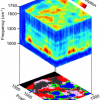While more research is needed to confirm the findings published in the FASEB Journal, the use of FT-IR spectroscopy could herald a fast and easy way to spot early signs of infection, cancer and difficult to diagnose neurological conditions. The research led by Professors Peter Lay and Georges Grau used Fourier transform infrared (FT-IR) spectroscopy to detect and characterise the release of sub-micron sized microvesicles.
Produced from the cell membranes of mammals, microvesicles play a role in cell communication and carry a “cargo” of RNA, DNA, proteins, lipids and other biomolecules that they use to dramatically change the biochemistry of other cells. Microvesicles are involved in normal physiology but are released into the bloodstream at higher levels during the acute and early development phase of many diseases. They are also potent vectors and mediators of disease, so detecting changes in their number and biochemistry could be helpful for spotting mechanisms of early diseases development.
The researchers used FT-IR spectroscopy to monitor microvesicle-biomolecular changes in white blood cells, known as monocytes, they stimulated with a component of deadly bacteria called lipopolysaccharide, comparing the changes to those in healthy, uninfected white blood cells. Lipopolysaccahride from various bacteria can reach the blood and cause septic shock, a life-threatening complication of sepsis where the body's infection-response can injure tissues and organs.
“We found a threefold increase in the number of microvesicles from white blood cells stimulated with lipopolysaccharide that points to a pathophysiological role for these microvesicles in bacterial infection and its subsequent immune response”, said study co-author Georges Grau at the University of Sydney’s Vascular Immunology Unit and Marie Bashir Institute for Infectious Diseases. “We also saw clear biomolecular changes—more lipids and proteins—in microvesicles produced by white blood cells stimulated by lipopolysaccharides, compared to those produced by resting white blood cells.”
The researchers also discovered that most of the “cargo” of RNA, DNA, lipids and proteins released by the white blood cells were contained within these microvesicles.
“This is very important since there is an enormous research effort looking at circulating RNA, DNA and proteins in blood as diagnostics of diseases and our results indicate that they are mostly carried in these microvesicles,” said senior author, Professor Peter Lay at the University’s School of Chemistry and Vibrational Spectroscopy Core Facility.
“In many respects, the microvesicles released under bacterial stimulation during an infectious episode are like viruses whereby the altered lipid content and increases and proteins appear designed to invade and change the biochemistry of target cells by releasing their DNA and RNA.
“This use of FTIR spectroscopy to analyse microvesicles provides a new way characterise the biomolecular differences in this model of septic shock-induced white blood cell-microvesicle and could easily be applied to other models of microvesicle release, notably in a range of inflammatory diseases.”









